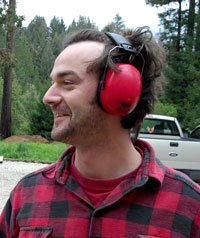R & D Focus: The drive for a lightweight, super-efficient motor

Diederik Marius
Unique direct-drive motors power Joby Energy airborne wind systems. Electrical engineer Diederik Marius leads the motor design team and after two years of research and development, says the team has made significant progress in producing a highly optimized motor. “One of the main engineering challenges was to design a brushless permanent magnet motor to attain high torque at low speeds, but with high power density (kW/kg),” Marius said.
Marius said that reaching high efficiency at low speeds is accomplished through very careful magnetic design for the motor and an optimal phase winding scheme. “In a way, our entire system works like a gearbox, since the propeller will see oncoming winds that are greater than actual wind speed because its circular flight pattern,” Marius said. “The success of our technology is highly dependent on system efficiencies — the motor needs to be lightweight and extremely efficient.” Marius said. “We’re working on improving efficiency of our motors to reach 95% efficiency or better — right now we are above 90% which is much more efficient than induction motors.”

10kW motor
“We’ve come a long-way in the design process,” Marius said. “Technically speaking, the design was complicated because the motors serve a dual role, first acting to power the system up and down and once the system reaches optimal operating altitude, its function shifts to power generation.”
While direct drive turbines are not new in the wind industry, Marius says that the design of our motor/generators is very specialized and unique. “They are optimized for reliability, safety, weight and longevity,” he said. “The motors are also quieter and have a longer life because with fewer parts, they are less prone to fail.”
The design team is currently building 5 kW motors for small airborne wind system prototypes while simultaneously building 20-30 kW motors for future vehicles. These motors will be used to pilot and test 30 and 100 kW systems in the short-term. Larger motors are planned for multi-MW commercial systems.
Marius is now concentrating on what the design team sees as another big challenge — designing the prototype motor controller. “Our motor controller is fairly complex. It needs to handle high electric current and voltage, needs to be lightweight and efficient both in motoring and generating mode,” he said. “It also needs to be highly reliable and robust, maintain optimal speeds and protect against overloads and faults.”
The multiple motors on our airborne wind energy system are each driven by a controller. “That greatly helps the safety our system,” Marius says. “This is one of the multiple redundancies of our system design — if one motor or controller fails, it will continue to fly or generate power because other motors/generators will take over its role.” Marius, a native of Belgium, received his M.S. in Engineering Physics from Ghent University and a M.S. in Electrical Engineering from Stanford University.
In addition to Marius, the prototype motor control team includes John Greene, Ganymede Stanek and Tom Smith. Piotr Esden-Tempski, an embedded systems engineer from Poland, is working on an additional motor control design.


